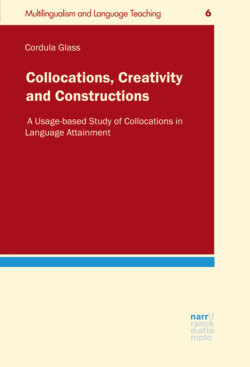Collocations, Creativity and Constructions

Реклама. ООО «ЛитРес», ИНН: 7719571260.
Оглавление
Cordula Glass. Collocations, Creativity and Constructions
Inhalt
Figures and Tables
Acknowledgements
1 Three sides of the same coin? – Collocations, Creativity, Constructions
2 Collocations as Constructions
2.1 Context-Oriented Approaches
2.2 Significance-Oriented Approaches
2.3 A Construction-Oriented Approach
3 Collocations and Creativity
3.1 Creative Variation of Collocations
3.2 Creativity and Cognition
4 Creating Linguistic Creativity
4.1 Nativist Approaches
4.1.1 Interpretive Semantics
4.1.2 Conceptual Semantics and Parallel Architecture
4.2 Constructionist Approaches
4.2.1 Emergentist Approaches
4.2.1.1 Rich memory
4.2.1.2 Categorisation
4.2.1.3 Chunking
4.2.1.4 Analogy
4.2.1.5 Cross-Modal Associates
4.2.1.6 Connectionism and Neuroscientific Implications
4.2.2 Social-pragmatic Learning
4.3 Phraseology and Language Acquisition
4.3.1 Construction Grammar
4.3.1.1 Non-compositionality
4.3.1.2 Inheritance Relations
4.3.1.3 Polysemy
4.3.1.4 Productivity and Creativity
4.3.2 A Stage Model
4.3.3 Complex Adaptive Systems
4.4 The DMCDC-Model: A usage-based model of collocations
4.5 Summary and Implications
5 Measuring Collocations – Methodological Considerations
5.1 Online Production Tasks – Corpus Data and Statistical Association Measures for Collocations
5.1.1 Traditional Association Measures
5.1.2 Corpus Data in Cognitive Linguistic Research
5.2 Offline Perception Tasks – Experimental Data in Usage-based and Constructionist Studies
5.3 Methodological Limitations and Shortcomings
5.3.1 Corpus Data
5.3.2 Judgement Tasks
5.4 Methodology of this Study
5.4.1 Instruments
5.4.1.1 CollMatch
5.4.1.2 CollJudge
5.4.2 Participants and Procedure
6 CollMatch
6.1 Native Speakers – Adult
6.2 Native Speakers – Children
6.3 Native Speakers – Patterns
6.3.1 Pattern 1: Gradual Acceptance
6.3.2 Pattern 2: Peaked Acceptance
6.3.3 Pattern 3: Steady Acceptance
6.3.4 Pattern 4: Receding Positive Evaluation
6.3.5 Distractors
6.3.6 Summary
6.4 Non-Native Speakers
6.4.1 Pattern 1: Gradual Acceptance
6.4.2 Pattern 2: Peaked and Dented Acceptance
6.4.3 Pattern 3: Steady Acceptance
6.4.4 Pattern 4: Receding Positive Evaluation
6.4.5 Distractors
6.4.6 Summary
6.5 Effects of Schooling
6.6 Summary and Implications
7 CollJudge
7.1 Native Speakers
7.1.1 Pattern 1: Preference of Established Variants
7.1.2 Pattern 2: Overall Acceptance
7.1.3 Pattern 3: Contextual Acceptance
7.1.4 Other Patterns
7.1.5 Summary
7.2 Non-native speakers
7.2.1 Pattern 1: Preference of Established Variants
7.2.2 Pattern 2: Overall Acceptance
7.2.3 Pattern 3: Contextual Acceptance
7.2.4 Pattern 4: Contextual Influence
7.2.5 Other Patterns
7.2.6 Summary
7.3 Comparing Corpus Data and Evaluations from Judgement Tasks
7.4 Summary and Implications
8 Main Results and Implications
8.1 Main Results of this Study
8.2 Limitations and Further Research
8.3 Implications for a Usage-based Approach Towards language
8.3.1 First Language Acquisition
8.3.2 Second Language Acquisition and Learning
Appendices. Appendix I: Questionnaire
Appendix II: CollMatch (Acceptance Scores)
Appendix III: REC items vs. alternate combinations
Appendix IV: Raw Frequency Rankings and Association Measures for CollJudge
Appendix V: CollJudge (z-transformed acceptance scores)
References
Dictionaries
Corpora
Fußnoten. 1 Three sides of the same coin? – Collocations, Creativity, Constructions
2 Collocations as Constructions
2.1 Context-Oriented Approaches
2.2 Significance-Oriented Approaches
2.3 A Construction-Oriented Approach
3.1 Creative Variation of Collocations
3.2 Creativity and Cognition
4 Creating Linguistic Creativity
4.1 Nativist Approaches
4.1.1 Interpretive Semantics
4.1.2 Conceptual Semantics and Parallel Architecture
4.2.2 Social-pragmatic Learning
4.3.1 Construction Grammar
4.3.2 A Stage Model
4.4 The DMCDC-Model: A usage-based model of collocations
4.5 Summary and Implications
5 Measuring Collocations – Methodological Considerations
5.1 Online Production Tasks – Corpus Data and Statistical Association Measures for Collocations
5.1.1 Traditional Association Measures
5.1.2 Corpus Data in Cognitive Linguistic Research
5.3.1 Corpus Data
5.3.2 Judgement Tasks
5.4.1.1 CollMatch
5.4.1.2 CollJudge
5.4.2 Participants and Procedure
6 CollMatch
6.1 Native Speakers – Adult
6.3.1 Pattern 1: Gradual Acceptance
6.3.2 Pattern 2: Peaked Acceptance
6.3.3 Pattern 3: Steady Acceptance
6.3.6 Summary
6.4 Non-Native Speakers
6.4.1 Pattern 1: Gradual Acceptance
6.4.2 Pattern 2: Peaked and Dented Acceptance
6.4.4 Pattern 4: Receding Positive Evaluation
6.4.5 Distractors
6.4.6 Summary
6.5 Effects of Schooling
7.1 Native Speakers
7.1.1 Pattern 1: Preference of Established Variants
7.1.2 Pattern 2: Overall Acceptance
7.1.5 Summary
7.2.1 Pattern 1: Preference of Established Variants
7.2.4 Pattern 4: Contextual Influence
7.2.6 Summary
7.3 Comparing Corpus Data and Evaluations from Judgement Tasks
8.1 Main Results of this Study
8.3.2 Second Language Acquisition and Learning
Отрывок из книги
Cordula Glass
Collocations, Creativity and Constructions
.....
Table 2.1: Lexical and grammatical relations (based on Halliday 1966: 152–153)
Table 2.2: Corpus-based association measures for “Humpty Dumpty’s collocations”
.....